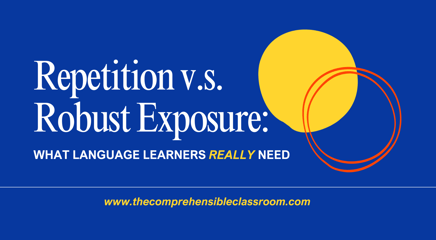I administer four kinds of summative assessments to my students:
- Reading comprehension assessments
- Listening comprehension assessments
- Presentational writing assessments
- Presentational speaking assessments
(Read here about why I don't administer summative Interpersonal assessments.)
Each quarter, I try to get three or four grades in the book for each of the first three assessment categories. I adopted this policy upon reflection from a webinar from Scott Benedict / Teach for June. Three or four assessments per category means that you are not likely spending so much time doing summative assessments that you never actually have time to learn new things, but it also allows for students to have good and bad assessments and still offer an accurate picture of their overall performance in the various domains.
Tonight, as I was grading dictations, I was reminded of the importance of varying the kinds of assessments that you administer within each category. I was shocked as I graded the first dictation that I gave my Spanish A students this year--some students could transcribe the sentence with incredible accuracy but drew inaccurate drawings; others completely (COMPLETELY) botched the transcription, but their illustrations were spot-on. It is important to vary the assessment type for the sake of your students, because all students have different strengths and weaknesses within a skill area. It is also important that you vary assessment format for your benefit, so that you can develop a clear picture of each student's strengths and struggles!  Here is a list of listening assessment formats that I have used in my classes. Click on the links where applicable to learn more!
Here is a list of listening assessment formats that I have used in my classes. Click on the links where applicable to learn more!
DICTATION - I know, I know--dictations are like, the stone age of listening assessments! But hear me out! Adding an illustration component ensures that this is still a listening comprehension assessment!! I love that it is so easy to grade with the rubric included.
DO YOU HEAR WHAT I HEAR? - Give students a list of five-ish statements in their L1. Read a series of five-ish FALSE statements in the target language (one that corresponds to each L1 statement). Students correct the information in the L1 statements to match the L2 statements.  FIRST OR SECOND? - I like this because putting events in their correct order requires a different kind of processing than just interpreting what you hear.
FIRST OR SECOND? - I like this because putting events in their correct order requires a different kind of processing than just interpreting what you hear.
TRUE/FALSE - Assessments shouldn't require degrees in rocket science. This one is so simple; how could I not include it!!
CIRCLE UP - Give students a list of images that correspond to items and ideas that are mentioned in a text, and include some that are not. Read a paragraph to the students (three-ish times) and have them circle pictures of things that meet a certain criteria, as in my Tengo tu love listening assessment where students have to circle things that the speaker has. (Other ideas are things that the person does in the morning, places that s/he likes to go, items of clothing that s/he buys at the store, etc.).
COMPREHENSION QUESTIONS - Students listen to a text in L2 and respond to comprehension questions in L1 (for my students, L2 was Spanish and L1 was English). It is important that the questions and answers be written in English so that you are truly assessing listening comprehension, and not writing or reading. If you have them read questions and respond in Spanish, you won't know if students are getting stuck on the reading, writing, or listening piece.
FIND THE DIFFERENCES - Show students a picture and then read aloud a selection in L2 that describes a slightly different picture. While students are looking at the picture and listening to the description of the similar but different picture, have students write down two or three things that are the same and two or three things that are different between the picture and the listening selection.
Q&A MIX N MATCH - I learned this one from Sharon Birch and LOVE it! It works well as an activity or as an assessment. To use it as an assessment, prepare a listening selection in Spanish. Then, write a list of questions about the selection in English and an answer bank with several non-examples, also in English. Students listen to the selection and then match the English questions and answers! As long as you have quality non-examples, this gives you an accurate picture of students' L2 listening comprehension.  FIND THE INTRUDER - I learned about this assessment from Elizabeth Dentlinger! It is a quick and stress-free when used with a written or spoken text or when used as an activity or an assessment--super versatile! Simply make five-ish statements about the text (for an assessment, use statements in L1, text in L2). One of them is false and the rest are true! Students must "find the intruder", or identify the single false statement.
FIND THE INTRUDER - I learned about this assessment from Elizabeth Dentlinger! It is a quick and stress-free when used with a written or spoken text or when used as an activity or an assessment--super versatile! Simply make five-ish statements about the text (for an assessment, use statements in L1, text in L2). One of them is false and the rest are true! Students must "find the intruder", or identify the single false statement.
SEQUENCE - Students listen to a story in L2 and put events (written in L1) in order. If events are in L2, it becomes a measure of both listening and reading comprehension. If you--like me--want to isolate skills for assessments, keep the text and the activity in separate languages! What are some of your go-to listening assessments? 




